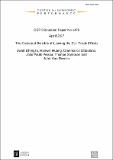The costs and benefits of leaving the EU: trade effects
Author(s)
Dhingra, Swati; Huang, Hanwei; Ottaviano, Gianmarco; Paulo Pessoa, João; Sampson, Thomas; Van Reenen, John Michael; ... Show more Show less
DownloadAccepted version (1.109Mb)
Terms of use
Metadata
Show full item recordAbstract
This paper estimates the welfare effects of Brexit in the medium to long run, focusing on trade and fiscal transfers. We use a standard quantitative general equilibrium trade model with many countries and sectors and trade in intermediates. We simulate a range of counterfactuals reflecting alternative options for European Union (EU)–United Kingdom (UK) relations following Brexit. Welfare losses for the average UK household are 1.3% if the UK remains in the EU’s Single Market like Norway (a ‘soft Brexit’). Losses rise to 2.7% if the UK trades with the EU under World Trade Organization rules (a ‘hard Brexit’). A reduced-form approach that captures the dynamic effects of Brexit on productivity more than triples these losses and implies a decline in average income per capita of between 6.3% and 9.4%, partly via falls in foreign investment. The negative effects of Brexit are widely shared across the entire income distribution and are unlikely to be offset from new trade deals.
Date issued
2017-10Department
Sloan School of ManagementJournal
Economic Policy
Publisher
Oxford University Press (OUP)
Citation
Dhingra, Swati et al. "The costs and benefits of leaving the EU: trade effects." Economic Policy 32, 92 (October 2017): 651-705 © 2017 CEPR, CESifo, Sciences Po
Version: Author's final manuscript
ISSN
0266-4658
1468-0327